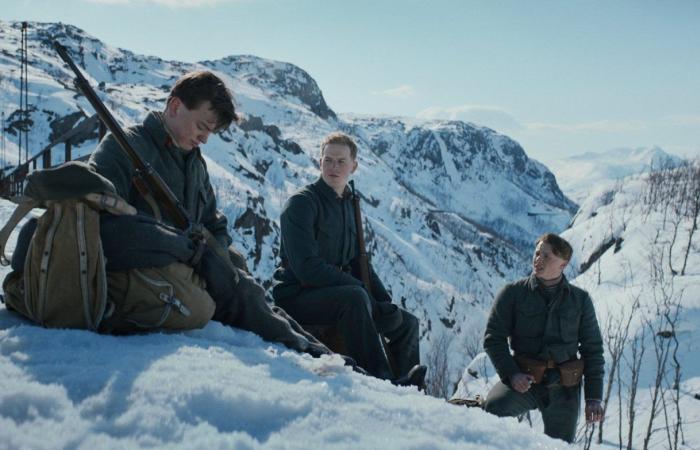“What does this smell like?” asks Narvik boy and corporal Gunnar Tofte when he and his military squad sail into the Ofotfjord towards his home town on the evening of 8 April 1940 in the first scene of “The Battle of Narvik – Hitler’s First Defeat”. Some answer salt water, but Tofte corrects bluntly: “No, it smells like iron ore; the smell of money!”
Malmbyen’s fighters
This is how the approach is set thematically for the most expensive Norwegian film production ever, the film which has already had several postponed launch dates on Norwegian screens; both during the pandemic and immediately after the outbreak of war and the Russian invasion of Ukraine last February. When you have seen the film, you will understand the delays. “This is war,” we hear the male protagonist Tofte dryly impress upon one of his wounded fellow soldiers who wants to give up in one of the most bloody and dramatic scenes of war in the film.
And that is exactly what this is; it is hard core war; close-ups of bloodied and mutilated bodies running across the screen, deafening explosions of shells and bombs resounding, crossfire and gunfire certainly above the recommended volume for cinema audiences, and wailing echo-carrying death screams in long tracks. Not a film for the faint of heart, and hardly a family film. I probably wouldn’t have brought a 12-year-old to this film either. People are dropping like flies, in the city’s streets and houses, there are fires and bombs, also in the majestic mountain landscape that surrounds the city of Narvik. One could hardly wish for a better cinematic arena than this on Norwegian soil; something director Erik Skjoldbjærg has exploited to the full with wide-angle shots and close-ups that really imprint themselves on the mind. We are led into the landscapes by a very close and relentless camera eye: City and village, mountain and fjord, faces distorted in pain and horror, and then the beautiful and powerful, majestic northern Norwegian nature as backdrop and backdrop.
Nature gives and takes, just as war does the latter. Here, the cold, frozen Nordic winter meets after every spring and summer. It’s also in the film’s interest; the changing seasons dress the format and narrative; after winter comes spring and summer; a small hope for peace is lit with the recapture of the city on 8 May, before it all ends with the total bombing of Narvik on 8 June 1940 and the capitulation of the inhabitants who are transported out on the local fishing boats that belonged to the city in its time. Cinematically, this is war drama of the highest order, and the historical narrative is Narvik’s own; a small town that was bombed to the ground during the Second World War, but not without brave and skillful resistance by 200 soldiers who broke out.
“Get out of Narvik!”
The bombing of Narvik is both a black chapter in our national history, but also a story of hope, stamina, short-lived joy of victory and courage. The cinematic narrative is sometimes good and suggestive that you are “sucked into” the screen with the nature and landscape that unfolds around Narvik. As the acts of war become rawer and more brutal, you almost have to hold on to the armrests of the chairs so as not to be mercilessly thrown into the scenic film space of war, blood and death. Out of sheer necessity, one has to pull oneself out of the drama unfolding on the screen, to be able to feel the cinema seat beneath one again in breathless distance from it all. It’s strong, and it needs to be. It is about perhaps our greatest national war trauma ever.
There is a lot of war and action in the film, but where did the historical figures from the outbreak of war in Norway and Narvik become? Generalmajor Carl Gustav Fleischer, commander of the 6th Infantry Division, for example, who was responsible for the Norwegian forces in northern Norway, and who the night before the attack moved an infantry battalion from Elvegårdsmoen to Narvik, and who, in the period after the outbreak of the war together with French , British and Polish allies managed to recapture Narvik on 28 May 1940.
It was also Fleischer who “saved” the Ofot railway and who gave the decisive order over the phone further north on 9 April 1940: “Get out of Narvik!” to Major General Sverre Spjeldnæs, who was battalion commander of I/IR 13 at the outbreak of war.
Under Fleischer’s leadership, the Germans suffered their first major defeat during the Second World War when Narvik was recaptured on 28 May 1940. In the film, actor Henrik Mestad has been given the role of Major General Spjeldnæs, who resolutely marches in front of his squad out of Narvik on command from Fleischer. The story tells that Spjeldnæs did not allow himself to be stopped by the Germans on the way out of the city, and that in the face of the German gun muzzles and orders to stop the exit, he had clearly expressed his protest in German as he continued to march: “Guten Morgen. Doch Wir marchieren!’ This scene in the film is unfortunately only a pale version of itself, as Mestads Spjeldnæs does not express this protest to any great extent, and is also in the middle of the group of soldiers on their way out of Narvik.
If the historical context is to be understood with a film about the Battle of Narvik, key information about the military background should be in place. So much for the educational part. Screenwriters Erik Skjoldbjærg, Live Bonnevie, Christopher Grøndahl and Sebastian Tomgren Wartin have written and prepared the blockbuster for seven years before the first day of filming could begin. They have done a good job with the script, despite the fact that the story of the battle lacks key people who pulled the strings when war broke out in northern Norway in 1940. The fiction needs absolutely crucial facts that set the story correctly in its time and provide historical consistency. Major General Fleischer should have been mentioned as the mastermind behind the military Norwegian resistance action, but it is not the first time that Fleischer has been “forgotten” when the story of the war in Norway is to be written and retold. But that’s another story.
His war, her fight
This is otherwise a war film at its best, and it is drama to well above average thanks to the personification in the film’s narrative. The young married couple Ingrid and Gunnar Tofte and their little son form the fictional core of the dramatic story of the invasion of Narvik under Hitler’s leadership when the war came to Norway during the Second World War. We get to know the small Tofte family to also better understand the war’s contrasts, consequences for the individual and for the families that were affected, as well as the war’s eternal ethical dilemmas.
It is “his war”, the soldier and corporal Gunnar Tofte; but there is also his young wife Ingrid’s private and human struggle and strife on the home front and at the hotel where she works as a maid and interpreter, and eventually becomes an important piece for the Germans and the British in the shadow of the occupation.
Ingrid becomes the soldier that no one sees; she who fought in the crossfire between her roles as mother, daughter, spouse, professional woman and loyal to her fatherland. Her loyalty will be tested in the film; and likewise her struggle to survive as a human being and as a mother. The heartbreaking fight for the son’s life alone in the ruins of Narvik is what perhaps carries the entire soul of the film. Ingrid Tofte becomes the film’s undisputed protagonist, and the role interpretation is nothing short of excellent. Six on the dice for Kristine Hartgen as Ingrid Tofte!
War acts, and is initiated by men at all times. In the midst of the rain of bombs and bullets, a young woman stands here as a distinctly strong and warm character, and at the same time an unshakable and strategically intelligent person. When the Germans invade the city, she becomes important for the entire resistance struggle and the invasion and the dialogue between Norway, England and Germany which could otherwise have broken down. She becomes a linguistic link between the warring parties who can contribute to the vital understanding and dialogue between the warring parties; a piece that cannot be dispensed with, but which can easily be misdirected into the enemy’s net. Which side is Ingrid really on as the action and the state of war develop around her? This becomes high-class drama in a game of truth and lies, speech and concealment.
And Ingrid becomes the drama queen; she is torn between loyalty to her country, her military husband, her family, her magnanimity, her work as an interpreter and her mother’s love. She is tested, she fails and succeeds and she almost fails in the last “act”; just like the heroine in a classic drama. And he remains a soldier in mind and deed, even after the guns have fallen silent. Carl Martin Eggesbø does an excellent role interpretation as the young corporal Gunnar Tofte. For him, the role of soldier is more important than life itself. It comes across well in the film.
Over the night
The heart of the dispute, and the film’s pivot point, is also the highly-priced iron ore, which has provided the economy for the small town since the beginning of the 20th century, in addition to the fishing industry. Ofotbanen was, and is, part of the Swedish “Malmbanan” which transports ore from Sweden via Narvik and out the fjord to the continent; where German war industry in particular has benefited from it for its weapons production. The fact that ore extraction stood so strongly as a motive for the outbreak of war in Narvik was partly because Hitler could not at that time find ore elsewhere for his weapons production. Narvik thus became a “gold mine” for Hitler, a place he had to occupy as soon as possible. We are in the film at the outbreak of the Second World War in Norway, where we were thrown into the war completely unprepared despite our position as a neutral power, and then occupied on Hitler’s command at the same time in Moss, Halden, Arendal, Kristiansand, Oslo, Egersund , Stavanger, Bergen, Trondheim and Narvik in the early morning of April 9, 1940. Hitler wanted the iron ore from Narvik to produce more weapons, and he wanted to use the railway and Ofotbanen to transport it out of Norway, south into Europe and into Germany . Iron ore meant money from the moment it was discovered under the rock, and since then it has played an important industrial role for the city throughout history.
Hitler won Narvik in the end, after the Allies withdrew in June 1940 and the city was bombed to the ground. A cruel event in Norwegian war history. And the film about it provides good insight into the consequences for Narvik and the town’s people of the fateful days in April, May and June 1940. But to call the battle for Narvik “Hitler’s defeat” is probably taking it a bit too hard, in a historical/military context perspective.
After watching the film, one is struck and stunned by all the poignant, violent and heartbreaking war scenes the film shows, and one thinks: “Do we really know today what peace is here in Norway, and what national freedom means?” And not least: “Could this happen again, and are we better prepared now?” There are many thoughts after this wintry film screening in the room Christmas wandering home in the cold in the capital on the hålkeføre between Gimle cinema and Briskeby fire station.
I can’t help but think of Henrik Ibsen. Almost 70 years before the outbreak of war in Norway, he wrote the poem “Bergmannen”, about the ore deep down in the rock as the image of the Norwegian folk soul and our tendency to look into the darkness (toward the ore), instead of lifting our gaze towards the light and the happening on the horizon.
Downward I must make my way until I hear the ore sounding…
Further clarifies
The author of this review, Birigitte C. Huitfeldt, is the grandson of Major General Sverre Spjeldnæs, who was battalion commander of I/IR 13 at the outbreak of war and who is mentioned both in the film and in Huitfeldt’s review.






